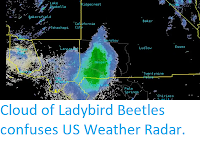Darkling Beetles, Tenebrionidae, are a morphologically diverse group with over 20 000 described species, and many more still being discovered every year. The genus Machleida is one of seven southern African genera, with five described species, four of which are known from single localities in the Eastern Cape Province of South Africa, with the fifth being found in Madagascar, leading to its placement within the genus questioned by entomologists.
In a paper published in the journal ZooKeys on 10 January 2019, Marcin Kamiński of the Department of Biological Sciences at Northern Arizona University, the Department of Entomology at Purdue University, and the Museum and Institute of Zoology of the Polish Academy of Sciences, Kojun Kanda of the also of the Department of Biological Sciences at Northern Arizona University, and Aaron Smith, again of the Department of Biological Sciences at Northern Arizona University, and the Department of Entomology at Purdue University, present a review of the genus Machleida, in which they describe four new species and formarly remove the Malagasy species, Machleida nossibiana, from the genus.
The first new species is named Machleida banachi, in honour of Stefan Banach (1892-1945), a prominent Polish mathematician and founder of modern functional analysis. The species is described from five specimens, collected in 1988 in what was then the Transkei Republic (now part of Eastern Cape Province) by Hungarian entomologist Sebastian Endrödy-Younga, four from Ntsubane Forest in and one from Ingogo Forest. This species ranges from 8.0 to 9.5 mm in length and from 4.0 to 7.0 mm in width, and is brownish in colour with abundant yellow hairs. It is typically covered in debris from the leaf litter in which it lives.
Machleida banachi, dorsal view. Kamiński et al. (2019).
The second new species described is named Machleida flagstaffensis, meaning 'from Flagstaff', in reference to the town in Eastern Cape, which is near the location where the species was discovered. This species is also based upon material gathered by Sebastian Endrödy-Younga in 1988, from the Ntsubane Forest and the Silaka Forest Reserve, also in the Eastern Cape. This species is much larger, reaching 13.0–15.0 mm in length and 7.0–7.5 mm in width. It is also brownish in colour with abundant yellow hairs, and typically covered in debris from the leaf litter in which it lives.
Machleida flagstaffensis, dorsal view. Kamiński et al. (2019).
The third species described is named Machleida tarskii, in honour of the Polish-American logician and mathematician Alfred Tarski (1901–1983). The species is described from two specimens collected by the Belgian entomologist Narcisse Leleup (1912-2001), in the Pirie Forest near King William's Town in Eastern Cape. This species reaches 9.0–9.2 mm in length, and 5.0–5.2 mm in width, and is dark brown or yellow in colour with abundant yellow hairs, and typically covered in debris from the leaf litter in which it lives.
Machleida tarskii, dorsal view. Kamiński et al. (2019).
The fourth new species described is named Machleida zofiae, in honour of Zofia Irena Kamińska, the daughter of Marcin Kamiński. This species is described on the basis of a single specimen collected in 1985 by Sebastian Endrödy-Younga in the Dwesa Forest Reserve in what was then the Transkei Republic and is now part of the Eastern Cape. This specimen is 11.5 mm in length and 5.5 mm in width, and brownish in colour with a coating of yellow hairs and a covering of debris from the forest floor.
The single Malagasy representative of the genus, Machleida nossibiana, has been considered to be a doubtful placement for some time. This is not uncommon with Malagasy species described in the nineteenth century, when it was not realised to what extent Madagascar represented a separate biogeographical realm to Southern Africa. Based upon re-examination of this species Kamiński et al.consider it should be placed in the genus Scotinesthes, as Scotinesthes nossibianus.
See also...
Machleida zofiae, dorsal view. Kamiński et al. (2019).
The single Malagasy representative of the genus, Machleida nossibiana, has been considered to be a doubtful placement for some time. This is not uncommon with Malagasy species described in the nineteenth century, when it was not realised to what extent Madagascar represented a separate biogeographical realm to Southern Africa. Based upon re-examination of this species Kamiński et al.consider it should be placed in the genus Scotinesthes, as Scotinesthes nossibianus.
See also...
Follow Sciency Thoughts on Facebook.










